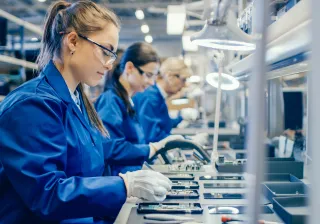Fabricated building components were commonly reused already centuries ago. It was necessary especially because of their scarcity caused by low industrialization and complicated supply chains. The concept of reuse has received a new attention in the last decade, but for different reasons. Today’s focus is on limiting the environmental impact of industrial production and at the same time preventing the generation of waste. Both goals can be achieved by recovering of existing functional components and materials and enabling their circulation in the built environment. Our advantage is that we, unlike our ancestors, have already very efficient supply chains and advanced industrial processes ready to take the whole concept to a new and more efficient level. We just need to understand that the future of our built environment is entirely in our hands.
Circular built environment
It is well known fact that the construction sector is the largest consumer of the natural resources and at the same time, it generates the largest amounts of industrial waste. Moreover, the level of digitalization in the construction is very poor in comparison to the other industries. One of the main reasons is the extremely long service life of the buildings and infrastructure. The common expectation is that the buildings’ life exceeds our own, thus we call it “the environment”. Consequently, the life-cycle performance of a single product or the whole construction work cannot be guaranteed by a single person or company, and it becomes a societal problem under the direct responsibility of local and national governments. These authorities define the targets and visions for the environmental efficiency of the future buildings.
Understanding our future
In order to answer the future needs and to deliver successful and functional solutions, we have to understand how the environment will look like after several decades. Certainly, many things will be more challenging than today such as the climate and demography. In addition, the knowledge of adverse effects of different materials on the human health and environment will increase, and we have to assume that any new material might be excluded from the circulation in the future. On the other hand, we expect that many new innovative technologies and services will be already well established in the building sector. These issues define the goals and boundaries of modern circular planning of the buildings and infrastructure.
The same methods, different goals
As stated in the Paris Agreement, the main goal of our generation is to undertake ambitious efforts to combat climate change in a coordinated global response. In Europe, the efforts are supported by numerous activities, especially by the EU Climate Action, Circular Economy Package and Waste Framework Directive. The targets relevant to the building sector are specified as
- 80-95% reduction of the industrial carbon footprint by 2050 compared to 1990
- 70% of construction and demolition waste to be recovered, recycled and reused by 2020
In order to respond to the remaining challenges, several additional goals might be needed such as
- Robustness and resilience of the built environment to sustain anticipated climate extremes and natural hazards
- Low maintenance demands in order to respond to the demographic changes in the future
- Traceability of material flows for the more flexible implementation of the policy instruments
We believe that the goals can be largely achieved with the existing methods and tools across the whole sector. For instance, the engineering work is traditionally focused on the optimized economic performance within given limits. The same approach can be used to minimize environmental footprint resulting for instance in different material choices and detailing of connections.
Design for …
As the focus is slowly shifting towards the environmental performance, several new design strategies emerged in the construction sector. Their use is mostly voluntary to support the sustainability certification of the building or neighbourhood.
- Design for deconstruction and flexibility (DfD) is considering at the design stage how a building can be taken apart allowing for effective recovery and spatial re-arrangement of building materials and components. The focus here is mainly on connections and interfaces.
- Design for end-of-life (DfEOL) is considering at the design stage one or more end-of-life scenarios including the communication of the relevant design information to the end-of-life industry. It naturally contains the DfD principles, as most of the end-of-life scenarios require deconstruction.
- Design for reuse and recovery (DfR) is a specific DfEOL approach taking into account deconstruction and reuse of building components as one of the basic requirements. The focus here is to minimize re-fabrication and redesigning in the future life cycle.
- Designing out waste (DoW) is different because its main focus is on the construction of the current building. It requires efficient use of available resources in order to minimise the waste amounts.
The strategies are very useful in the sense that they communicate the goals defined by the authorities into the engineering requirements. Therefore, it is in our interest to continue with their development and implementation.
The story of steel reuse
VTT recognizes the societal need to establish a closed loop of building components in order to increase environmental benefits and value of the building stock, and therefore we have started many activities with national and international collaboration. One of the research projects that strives to support the construction and demolition industry to adapt to the challenges of Circular Economy is called PROGRESS, Provisions for a Greater Reuse of Steel Structures. The project is coordinated by VTT and jointly funded by the European Commission’s Research Fund for Coal and Steel (RFCS), Ruukki Construcion, Jernkontoret, Ramboll Finland, Peikko Group and all the project partners.
Although we believe that the Circular Economy principles are independent on the material, we chose the structural steelwork for our research for several reasons:
- Constructional steel is almost entirely collected and recycled in EU. This means that the existing supply chain can be used, while in the case of different materials, we would need to cover some gaps. It also means that there is not possible any breakthrough improvement in the recycling itself, and therefore reuse is the logical next step towards the carbon footprint reduction.
- Constructional steel is already reused. The assembled steel buildings naturally cover most of the requirements of the Design for Deconstruction and Design for Reuse because of their bolted connections and durable material. However, the examples of their successful reuse are only isolated projects. This concept can be upscaled to a more systematic and industrialized way.
- All materials will benefit from the innovations of steel reuse. At the moment, we have only limited possibilities to create reversible connections and interfaces that can be constructed the same way as deconstructed. Therefore, most of the modern dismountable building systems rely on bolted or clamped steel connections regardless the primary building material.
PROGRESS project focuses on increasing the share of reused steel components. While recycling rate of steel increased from 93% to 96% between 2000 and 2014, reuse rates are reported to be stagnating in the same period.
The particular objectives of the project are to
- Extend the service life of building elements by reusing them after their removal from the original structure,
- Reduce the raw material and energy consumption of steel sector, and embodied impacts of the steel buildings,
- Develop the design guidance for the successful planning of assembled structures with reused elements and the buildings that will be deconstructed in the future to maximize the reuse potential of their elements and systems,
- Establish the quality verification process, testing and evaluation methods, and develop the related services and business models in order to enable reuse of building elements recovered from the demolition or renovation activities,
- Improve the overall building performance by improvement of multi-material and multifunctional hybrid systems reusability,
- Demonstrate the reuse process/technologies, related circular economy models and environmental benefits on selected case studies,
- Involve all actors in the product supply chain to actively participate and contribute to the attainment of the project objectives by direct collaboration and workshops.
The PROGRESS project is targeting significant material streams within the steel sector. With many existing single-storey steel buildings (SSB) components already highly reusable (due to the reversible joining and assembly methods), it is estimated that 80% of current SSB structural steel could be reused instead of recycled. We also have many good examples of recent product innovations ranging from detachable components to the whole pilot buildings. However, the fact that something is possible to do does not mean automatically that it will be done in a large scale. In reality only about 5% of constructional steelwork is reused now and the lack of systemic innovations of the whole value chains is clearly evident in this area. PROGRESS is addressing this innovation gap, which is one of the reasons that it has been selected as "the most innovative service or project at the Construmat Building Fair in Barcelona in May 2019".





